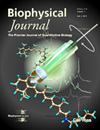Membrane protein hydration bridges polymer physics and biology.
IF 3.1
3区 生物学
Q2 BIOPHYSICS
引用次数: 0
Abstract
Understanding the role of water in membrane protein structure and function is crucial for elucidating the mechanisms that govern cellular processes. Recent experiments with the G-protein-coupled receptor (GPCR) archetype rhodopsin have shed light on polymer osmotic effects as an important metric for studying hydration in membrane protein activation. Still, to gain mechanistic insights into the multifaceted problem of membrane protein hydration involving lipids, membranes, and polymers, one needs information at atomistic resolution. Recent advances in molecular dynamics simulations have made capturing such information possible. Here we review membrane protein hydration as a multidisciplinary research topic at the intersection of polymer physics and biology through a computational lens using rhodopsin as an example. Recent advances and challenges in spectroscopic and structural approaches to study hydration in proteins are discussed generally, and for membrane proteins specifically. We explore the synergy between polymer physical chemistry and membrane protein hydration by reviewing the contributions of lattice models, polymer osmolytes, and crowding to motivate the need for computational methods in studying membrane protein hydration. Finally, we discuss recent advances in understanding hydration in membrane proteins, using rhodopsin as an example, through hybrid Monte Carlo/molecular dynamics simulations.膜蛋白水合作用是高分子物理学和生物学的桥梁。
了解水在膜蛋白结构和功能中的作用对于阐明控制细胞过程的机制至关重要。最近对g蛋白偶联受体(GPCR)原型紫红质的实验揭示了聚合物渗透效应是研究膜蛋白活化水合作用的重要指标。然而,为了深入了解膜蛋白水合作用涉及脂质、膜和聚合物的多方面问题,人们需要原子级分辨率的信息。分子动力学模拟的最新进展使捕获此类信息成为可能。本文以视紫红质为例,通过计算透镜回顾了膜蛋白水合作用作为高分子物理学和生物学交叉的多学科研究课题。本文综述了光谱和结构方法研究蛋白质水合作用的最新进展和面临的挑战,特别是膜蛋白。我们通过回顾晶格模型、聚合物渗透物和拥挤的贡献来探讨聚合物物理化学与膜蛋白水合作用之间的协同作用,以激发对膜蛋白水合作用研究的计算方法的需求。最后,我们以紫红质为例,通过混合蒙特卡罗/分子动力学模拟,讨论了理解膜蛋白水合作用的最新进展。
本文章由计算机程序翻译,如有差异,请以英文原文为准。
求助全文
约1分钟内获得全文
求助全文
来源期刊

Biophysical journal
生物-生物物理
CiteScore
6.10
自引率
5.90%
发文量
3090
审稿时长
2 months
期刊介绍:
BJ publishes original articles, letters, and perspectives on important problems in modern biophysics. The papers should be written so as to be of interest to a broad community of biophysicists. BJ welcomes experimental studies that employ quantitative physical approaches for the study of biological systems, including or spanning scales from molecule to whole organism. Experimental studies of a purely descriptive or phenomenological nature, with no theoretical or mechanistic underpinning, are not appropriate for publication in BJ. Theoretical studies should offer new insights into the understanding ofexperimental results or suggest new experimentally testable hypotheses. Articles reporting significant methodological or technological advances, which have potential to open new areas of biophysical investigation, are also suitable for publication in BJ. Papers describing improvements in accuracy or speed of existing methods or extra detail within methods described previously are not suitable for BJ.
 求助内容:
求助内容: 应助结果提醒方式:
应助结果提醒方式:


